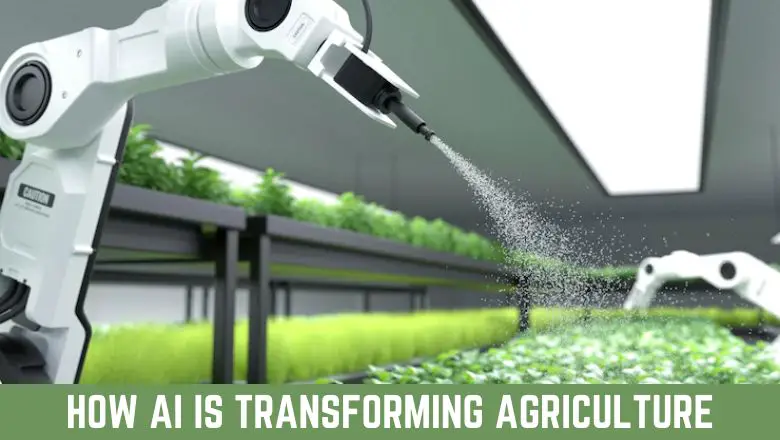A majority of the world’s population used to depend on agriculture for their livelihood, but now the situation has changed. In this article, we will put light on How AI is Transforming Agriculture and why we need it in food farming.
Since the beginning of human civilization, agriculture has flourished throughout the world. Agricultural techniques and practices have evolved over time as a result of innovation. AI is the recruit to farms.
As a result of industrialization, people shifted from agriculture to industries for employment. As a result, the agricultural labor force is reduced.
The UN Food and Agriculture Organization estimates that the world’s population will grow by 2 billion by 2050. By then, only 4% of the additional land will be cultivated.
More scientific and modern approaches are needed today to enhance agriculture in order to feed an expanding population with less labor force and less land.
Agricultural AI (artificial intelligence) is one of the best scientific solutions to boost productivity with fewer labor hours, efforts, and costs.
Farmers are able to better understand crops and problems associated with them as a result of this technology.
Role of Artificial intelligence in Agriculture:
Due to the necessities of life and the modern industrial world, agriculture is unavoidable.
A key to many locks can be found in artificial intelligence and machine learning in agriculture. Global hunger can be combated by eliminating many hurdles in the production of food.
This is one of the enhancing and innovative steps toward ensuring the continuity of this sacred profession. For this life-dependent sector to expand, more innovations are needed.
The scope of artificial intelligence in agriculture needs to be understood in this technological era.
AI in predictive agriculture:
AI technologies connected to the internet provide growers with predictions about their crops. It is possible to use AI as an early warning system. A month’s weather forecast can be predicted by analyzing and predicting data about climatic conditions.
It is better for growers to be aware of upcoming unfavorable conditions in advance in order to adopt precautionary measures and take care of themselves.
Large yearly data sets are also stored that provide information about a particular area’s weather and rainfall patterns. Farmers can use it to find out information about clouds, UV index, storms, sun duration, and daylight duration.
Artificial intelligence is a preserver for agriculture. Predictions are helpful in many aspects of farming, including:
- Sowing and harvesting dates can be set later or earlier based on this pre-known information.
- Farmers can cover the grain of harvested crops and harvest them earlier if rainfall is expected, which reduces their losses.
- A farmer can select the best seed, crop rotation, and cropping pattern based on the climatic and environmental conditions yearly by knowing the climatic and environmental conditions.
AI in detecting pests and pathogens:
Pests and diseases are the major causes of agricultural losses worldwide. Crop failure can be significantly reduced and losses can be significantly reduced when timely information about pests and diseases is available.
It is possible to detect diseases and pest attacks in crops using artificial intelligence technology developed in agriculture. For detection purposes, digital apps are available.
With these apps, simple images captured with the camera can be used to detect diseases and pathogens. A large database, which contains millions of images and different models of diseases and pest attack symptoms, is used to store this image.
The AI compares these images with the prescreened data collected by scientists. Based on that data, the AI determines which disease and pest attack the image matches and displays that information.
As a result of the AI analysis, the app displays data that contains plant species, pest or pathogen race, and disease name. It is possible to further investigate disease control or precautionary strategies to avoid losses based on all this information.
AI chatbots for agriculture solutions:
Artificial intelligence in agriculture has helped farmers get instant responses, which is one of its many benefits.
A farmer in a developing country is usually illiterate and unable to learn technical methods for using technology or writing queries on a device.
In agriculture, chatbots are developed on mobile apps that respond instantly to farmers’ oral questions. Answers to questions about commodity prices, farming news, and weather are provided by the chatbots.
In addition to providing timely analyzed information, these chatbots direct customers to the company’s database.
Further, chatbots can connect farmers to agricultural extension centers and call centers operated by governments and private companies. Firms such as these provide guidance and assistance in resolving problems.
Artificial intelligence in precision agriculture:
In agriculture, artificial intelligence offers immense advantages in terms of precision operations.
A drone can provide brief information on the field by imaging the field using high-quality thermal imagery.
An analytical tool for field conditions is the use of thermal images. Different field problems are depicted in these thermal images. Thermal images can reveal a variety of issues, such as soil, nutrient, and irrigation problems in the field.
Fields are typically treated uniformly when it comes to irrigation, fertilizer application, and soil management.
AI Thermal images have become a more innovative approach to field management. Different areas of the field have different problems that require variable control, as shown by the graph.
A farmer can use this approach to precisely treat a problem, get the most out of every part of the field, and save time and money compared to treating the whole field uniformly.
AI and robotics in Agriculture:
The idea of using artificial intelligence for agriculture proved to be a stunning one. A number of companies are working on leveraging AI to empower farmers to meet crop production challenges.
Agricultural yield losses are caused by weeds, one of the most challenging problems. Controlling weeds with herbicides increases production costs and creates environmental pollution that affects humans and animals.
Herbicide expenditures and pollution can be reduced by using artificial intelligence in agriculture.
A variety of weed-killing robots with artificial intelligence are developed with varying modes of operation.
The robot database is fed with information about the morphology and general appearance of weed. It detects weeds through cameras or sensors and sprays only the weeds while leaving the crop untreated.
With this new method of AI sprayers, herbicides’ effects on crops and the environment were reduced. Additionally, it reduced the problem of labor shortages and herbicide costs.
The volume of herbicide used was reduced with selective spraying. It is not necessary to spray the entire field and robots do the work instead of humans.
AI in harvesting crops:
Artificial intelligence is becoming increasingly important in agriculture to overcome labor shortages. A variety of autonomous robots that use AI and harvest different crops and fruits have been developed by high-tech and advanced companies.
Data about crop plants and fruits are fed into robot databases. To distinguish between ripened and unripened fruit, sensors and cameras are used.
Crops and fruits are harvested by these robots at a much faster pace and with a much greater volume than human labor. With cameras and sensors, they are able to distinguish between fruits and harvest ripened fruit precisely and carefully.
AI drones in agriculture farms:
Drones are a new tool for monitoring crops and fields. In different fields, drones have been used for various purposes. Now, they are being used in agriculture as well.
The drones are equipped with powerful cameras that can detect a number of problems in the field that would otherwise be difficult to see from the ground. Humans would take much longer to detect it.
It is possible to detect diseased plants and pest infestations in the field with these drones.
The drones can be fitted with different AI devices and sensors that can gather important data for farmers to analyze their farming. In this way, the farmer can track the production and outcome of his crops.
Agricultural drones equipped with artificial intelligence can assist in mapping and field management, and they can become more significant with more innovation. If remodeled, they can be used to broadcast seeds and spray specific areas of the field.
The Final Opinion:
It is the responsibility of the agriculture sector to feed the world. With the rapid growth of the population and the shifting of labor from agriculture to industry, global food security is at risk.
Agricultural innovation is needed to address these issues in the current environment.
Modern and autonomous farming has been greatly helped by the use of artificial intelligence in agriculture projects.
By increasing research and innovation in artificial intelligence and agriculture, global food security and food production can be improved.
keep up reading and learning with Rehmat Ullah.

